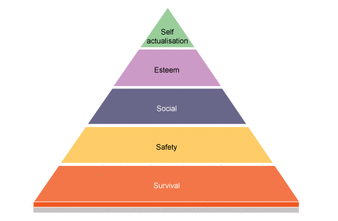2.5 Motivation
What will we study?

- Understand what motivation is and analyse intrinsic needs and extrinsic needs
- Discuss the motivational theories of Taylor, Maslow, McGregor andHerzberg and their relevance to business today
- Evaluate different forms of financial motivation and their impact on motivation
- Assess the role of non-financial methods of motivation and evaluate their impact
- Apply the content theories of Mayo and McClelland and the process theories of Vroom and Adams
Extrinsic vs. intrinsic motivation
Intrinsic motivation is when you want to do something. This often happens when you get satisfaction from an activity itself without threats or rewards from outside. People are more likely to be intrinsically motivated if they can see their success is result of something that they have done. Therefore they know that if they put in more work they will achieve more positive outcomes. These people are likely to be interested in the work they are doing and are given a degree of freedom in their job.
Extrinsic motivation is when somebody else tries to make you do something. An example would be financial rewards or something similar to the video below......
Extrinsic motivation is when somebody else tries to make you do something. An example would be financial rewards or something similar to the video below......
Motivational theories

Managers can make use of a number of motivational theories to help encourage employees to work harder.
Taylorism argues that staff do not enjoy work and are only motivated by threats and pay. Managers motivate staff by organizing employees' work and paying by results, eg piece rate pay - payment per item produced.
Maslow suggests there are five hierarchies or levels of need that explain why people work. Staff first want to meet their survival needs by earning a good wage. Safety needs such as job security then become important, followed by social, self-esteem and self-fulfilment needs. Moving staff up a Maslow level is motivational.
Taylorism argues that staff do not enjoy work and are only motivated by threats and pay. Managers motivate staff by organizing employees' work and paying by results, eg piece rate pay - payment per item produced.
Maslow suggests there are five hierarchies or levels of need that explain why people work. Staff first want to meet their survival needs by earning a good wage. Safety needs such as job security then become important, followed by social, self-esteem and self-fulfilment needs. Moving staff up a Maslow level is motivational.
Would this motivate you to do a better job ?
Four main motivational theories you need to know

Maslow
Maslow created what is know as the hierarchy of needs.
In this diagram, there are 5 different types of motivation:
Businesses realize that the more levels of motivation are available to workers, the harder they will work. Maslow also suggest that each level of motivation must be achieved before going to the next level. Once one level of motivation is met, more of that will no longer motivate the employee.
Strengths:
Theory:
Maslow created what is know as the hierarchy of needs.
In this diagram, there are 5 different types of motivation:
- Physiological needs: basic requirements for survival.
- Security needs: the need to by physically safe.
- Social needs: the need to belong and have good relationships with co-workers.
- Esteem needs: the need for self-respect and to be respected by others.
- Self-actualization needs: the need to reach your full potential and be promoted.
Businesses realize that the more levels of motivation are available to workers, the harder they will work. Maslow also suggest that each level of motivation must be achieved before going to the next level. Once one level of motivation is met, more of that will no longer motivate the employee.
Strengths:
- Maslow's model has great potential appeal in the business world. The message is clear - if management can find out which level each employee has reached, then they can decide on suitable reward
- Some levels are not present in some jobs.
- Some rewards belong to more than one level on others.
- Managers have to be able to identify the levels of motivation in any job before using it to motivate employees.
- The same need (e.g. the need to interact socially at work) may cause quite different behavior in different individuals
- There is a problem in deciding when a level has actually been "satisfied"
- The model ignores the often-observed behavior of individuals who tolerate low-pay for the promise of future benefits
- There is little empirical evidence to support the model. Some critics suggest that Maslow's model is only really relevant to understanding the behavior of middle-class workers in the UK and the USA (where Maslow undertook his research).
Theory:
- Money is the main motivator.
- If employees are paid more, they work more.
- Work is broken down into simple processes, and more money is paid which will increase the level of productivity an employee will achieve.
- The extra pay is less than the increased productivity.
- Workers are seen rather like machines, and this theory does not take into account non-financial motivators.
- Even if you pay more, there is no guarantee of a productivity rise.
- It is difficult to measure an employees output in certain professions.
Pink's Drive Theory
Daniel Pink is a modern writer on business & management, with a strong focus on the changing nature of work and the workplace. His book - Drive: the Surprising Truth About What Motivates Us - was published in 2009 and very quickly became a bestseller with its focus on the importance and effectiveness of three intrinsic elements to motivation at work: autonomy, mastery and purpose.
Pink argues that the evidence of scientific studies on motivation and rewards suggests that, for any work task that involves most than the most basic cognitive challenge, basic financial reward systems simply do not work. In fact, they can lead to worse performance.
For simple, straightforward tasks, Pink concedes that traditional financial rewards or a carrot & stick approach to motivation DO work. These can be considered as "external" methods of motivation. They are simple and they still work.
He accepts that money is a motivator at work, but once people perceive that they are paid fairly, then they become much more motivated by intrinsic elements. Once people are paid fairly, they look for more from their work.
A summary of Pink's key points on the three intrinsic elements of motivation is provided below.
Autonomy
Pink argues that allowing employees autonomy runs counter to the traditional view of management which wants employees to "comply" with what is required of them. However, if managers want employees to be more engaged in what they are doing (and they should - as tasks become more complicated) then allowing employees autonomy (self-direction is better). Pink provides some examples of what he means by autonomy, summarising them into four main aspects: time, technique, team and task. For example, some firms allow employees to have time at the workplace to do whatever they want. This freedom to spend time doing their own thing leads to many more innovative ideas and solutions. A good example is Google which has benefited from numerous product ideas as a result of allowing developers to pursue individual projects during work time.
The growth of flexible working practices is another good example of allowing staff more autonomy. For example, providing the technology and freedom to work from home.Pink is an advocate of greater use of teamwork as a means of facilitating autonomy, particularly where the team members themselves pick the team!
Mastery
Pink describes mastery as the desire to continually improve at something that matters.
Pink argues that humans love to "get better at stuff" - they enjoy the satisfaction from personal achievement and progress. Allowing employees to enjoy a sense of progress at work contributes to their inner drive.
By contrast, a lack of opportunity at work for self-improvement or personal and professional development is liable to make employees more bored and demotivated
A key implication for managers to is to set tasks for employees that are neither too easy or excessively challenging. Pink calls such tasks "Goldilocks tasks) - ie. tasks that are not "too hot or too cold". Goldilocks tasks push employees out of their comfort zones, and allow them to stretch themselves and develop their skills and experience further.
Purpose
Pink describes purpose as the desire to do things in service of something larger than ourselves. Pink argues that people intrinsically want to do things that matter.For example, entrepreneurs are often intrinsically motivated to "make a difference" rather than simply aiming for profit maximisation.
Most of us spend more than half our working hours at work. We want that time to matter.
So a key part of adding purpose to work is to ensure that the mission and goals of the organisation are properly communicated to employees. Employees need to know and understand these, and appreciate how their work and role fits into what the organisation is about.

Herzberg
To Herzberg, humans have hygiene factors, or basic animal needs of humans. We also have motivational factors/motivators, that are required for the human to grow psychologically.
Hygiene factors:
Motivational factors:
To Herzberg, if the hygiene factors are not satisfied, they will act as demotivators. They are not motivators, since the motivating effect quickly wears off after they have been satisfied. True motivators are are Herzberg's motivational factors.
According to Herzberg, management should focus on rearranging work so that motivator factors can take effect. He suggested three ways in which this could be done:
- Job enlargement
- Job rotation
- Job enrichment
This resulted in more businesses assigning workers complete units of work rather than the Fordist production method of leaving workers to assemble one small part of a finished product.
Limitations
Herzberg Theory can be a disadvantage to managers where employees with low motivation needs are concerned. Usually less-educated employees do not have the need for achievement and self-actualisation. Basic hygiene needs are all it takes to satisfy them.
If managers fail to identify these types of employees, the theory could backfire if applied. Instead of being motivated and having a sense of achievement, these employees would only be overwhelmed by the work content. They might also be dissatisfied, even though their basic needs have been fulfilled.
Also, certain hygiene factors are motivators to some individuals. Take for example money. Money is a hygiene factor, based on Herzberg’s Theory, but it is a motivation for a lot of employees. It motivates them to work harder in order to gain recognition, which translates into a higher salary.
Herzberg’s Theory parallels Maslow’s Hierarchy of Needs, thus making it easier to apply. However, the methodological bias that exists makes the theory questionable to some extent. Managers can apply the theory to motivate employees by identifying the hygiene and motivation factors. Individual differences must still be taken into account because not every employee would appreciate this method.
Read more: http://www.theborneopost.com/2012/10/23/a-critical-assessment-of-herzbergs-theory-of-motivation/#ixzz3RPXVQWco
To Herzberg, humans have hygiene factors, or basic animal needs of humans. We also have motivational factors/motivators, that are required for the human to grow psychologically.
Hygiene factors:
- Status.
- Security.
- Working conditions.
- Company policies and administration.
- Relationship with supervisor.
- Relationship with subordinates.
- Salary.
Motivational factors:
- Achievement.
- Recognition.
- Personal growth/development.
- Advancement/promotion.
- Job satisfaction.
To Herzberg, if the hygiene factors are not satisfied, they will act as demotivators. They are not motivators, since the motivating effect quickly wears off after they have been satisfied. True motivators are are Herzberg's motivational factors.
According to Herzberg, management should focus on rearranging work so that motivator factors can take effect. He suggested three ways in which this could be done:
- Job enlargement
- Job rotation
- Job enrichment
This resulted in more businesses assigning workers complete units of work rather than the Fordist production method of leaving workers to assemble one small part of a finished product.
Limitations
Herzberg Theory can be a disadvantage to managers where employees with low motivation needs are concerned. Usually less-educated employees do not have the need for achievement and self-actualisation. Basic hygiene needs are all it takes to satisfy them.
If managers fail to identify these types of employees, the theory could backfire if applied. Instead of being motivated and having a sense of achievement, these employees would only be overwhelmed by the work content. They might also be dissatisfied, even though their basic needs have been fulfilled.
Also, certain hygiene factors are motivators to some individuals. Take for example money. Money is a hygiene factor, based on Herzberg’s Theory, but it is a motivation for a lot of employees. It motivates them to work harder in order to gain recognition, which translates into a higher salary.
Herzberg’s Theory parallels Maslow’s Hierarchy of Needs, thus making it easier to apply. However, the methodological bias that exists makes the theory questionable to some extent. Managers can apply the theory to motivate employees by identifying the hygiene and motivation factors. Individual differences must still be taken into account because not every employee would appreciate this method.
Read more: http://www.theborneopost.com/2012/10/23/a-critical-assessment-of-herzbergs-theory-of-motivation/#ixzz3RPXVQWco
